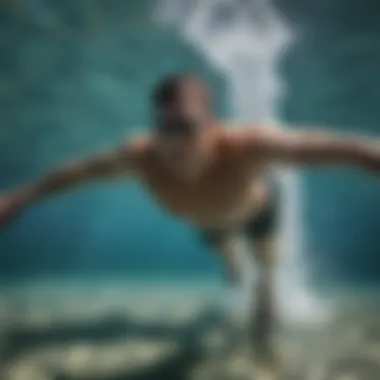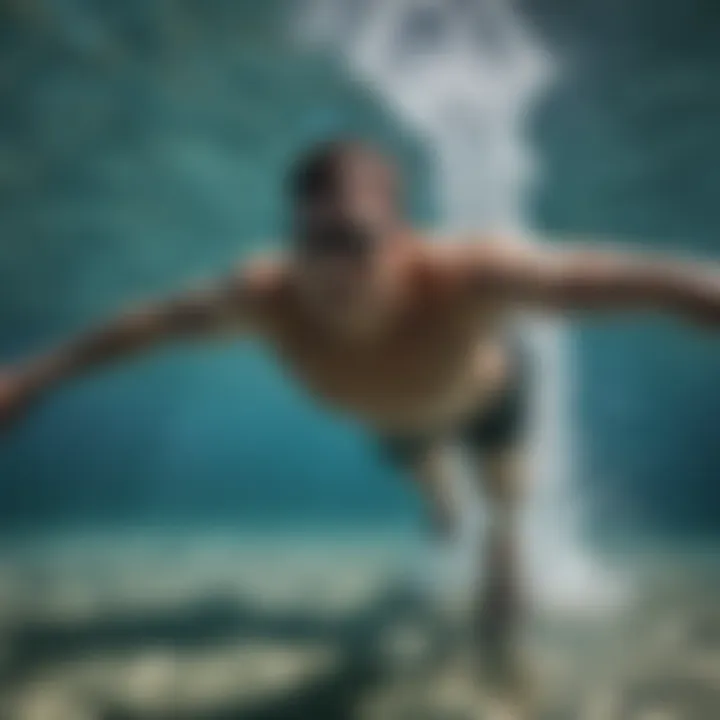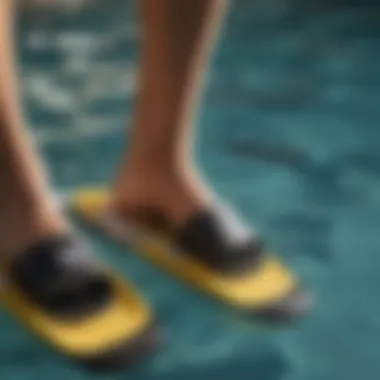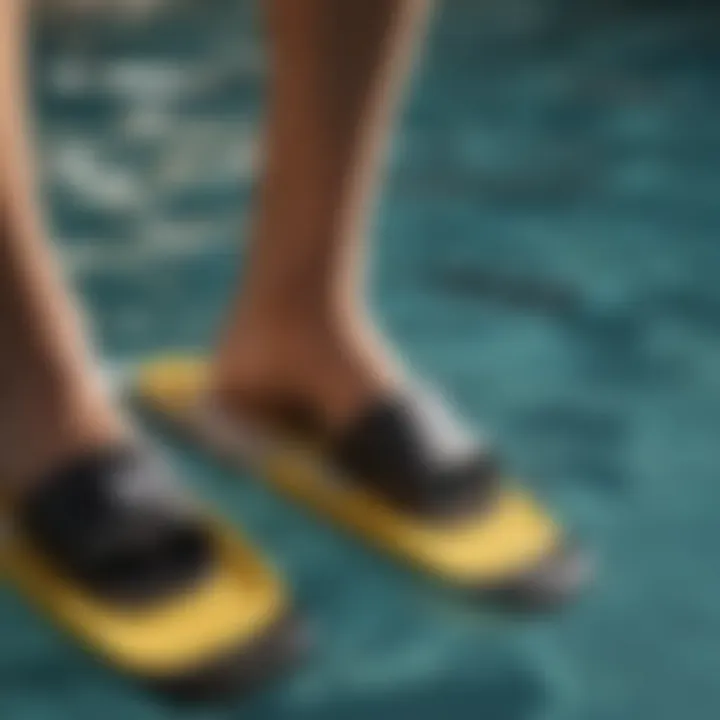Swimming Flippers: A Complete Guide to Performance


Intro
Swimming is a delightful activity, engaging both body and mind while allowing individuals to connect with water in diverse ways. Among the many tools that have transformed how we swim, flippers—often referred to as fins—stand out as pivotal additions to the swimming gear arsenal. They not only enhance speed but also improve technique, making them indispensable for enthusiasts of all skill levels.
As one submerges into the world of flippers, numerous factors come into play. Understanding the design, benefits, and appropriate usage of flippers can sharpen one’s skills and elevate performance in various aquatic activities. Whether you’re a novice dipping your toes into the pool or an expert tackling challenging waves, this guide takes you through the ins and outs of these essential tools.
"Choosing the right flippers is like finding the perfect pair of shoes; they enhance your performance when they fit just right."
This article will break down the key aspects of flippers, addressing various swimming styles, specific techniques suitable for different experience levels, and crucial safety considerations that every swimmer should follow. Let's dive deeper into the techniques and skills necessary for optimizing your aquatic experience.
Understanding Flippers
To truly appreciate the nuances of swimming, one must first grasp the essential role of flippers in enhancing aquatic performance. Flippers, also known as fins, are not just decorative additions to your swimming gear; they serve as vital tools that can significantly boost a swimmer's efficacy in the water. Understanding what flippers are, their applications, and their historical journey paints a clearer picture of how these instruments have evolved and benefited water enthusiasts over time.
Definition of Flippers
Flippers are specialized rubber or silicone tools worn on the feet designed to assist swimmers in moving more efficiently through water. They come in various shapes, sizes, and materials depending on their intended use—whether for casual swimming, training, or competitive purposes. In essence, flippers amplify the surface area of your feet, enabling swifter propulsion with each kick.
At their core, flippers enhance thrust, enabling swimmers to glide more easily and fluidly through the water. The blade’s stiffness and length can influence performance; for example, longer blades tend to foster more power, while shorter blades may facilitate better maneuverability. It’s not just about speed; flippers also aid in building leg strength and improving kick technique, essential components for mastering swimming styles like freestyle and butterfly.
Historical Context
The journey of flippers is quite fascinating, harking back to the early 20th century when the sport of swimming was transforming. Swim flippers were initially inspired by marine life, attempting to mimic the natural movements of fish during swimming. Early examples used to be quite rudimentary, often crafted from materials that we want describe as less than optimal.
As technology advanced, so did the designs of flippers. The 1930s marked a significant turning point when rubber and lightweight materials began to be used, making them more effective and comfortable for swimmers. Not just for leisure, by the late 20th century, they became staples in competitive training regimens. Many elite athletes started integrating flippers into their routines to build stamina and improve their overall technique.
Overall, the evolution of flippers reflects broader changes in swim technology and competitive practices. These humble tools play a pivotal role in many athletic careers while also introducing a fun, dynamic element to recreational swimming. With underwater performance becoming an art, the significance of understanding flippers cannot be overstated for anyone vested in mastering the aquatic domain.
Types of Flippers
When it comes to swimming, the type of flippers can significantly influence performance and comfort in the water. Understanding the different types tailored for varied activities helps swimmers make informed decisions. It's not just about choosing a flipper; it’s about aligning it with one's swimming goals, whether leisurely splashing around or seeking competitive glory. Knowing what each type offers brings a swimmer closer to achieving their desired aquatic experience.
Recreational Flippers
Recreational flippers are designed with the casual swimmer in mind. They emphasize comfort, ease of use, and enjoyment over performance. These flippers often have a wider foot pocket, making them easier to slip on and off. They tend to be shorter than their competitive counterparts, allowing for relaxed, gentle kicks that won’t tire out the legs too quickly.
For example, the Cressi Swim Fins are ideal for families and casual beachgoers. Their flexible blade design allows users to paddle through calm waters without overexertion.
When considering recreational flippers, it’s worth noting:
- Versatility: Great for both swimming and snorkeling.
- Comfort: Soft materials generally used prevent blisters or discomfort during extended use.
- Affordability: Generally lower-priced compared to competitive flippers.
Competitive Flippers
For the athlete in mind, competitive flippers take a different approach. They aim to enhance speed and streamline motion in the water. These flippers are typically longer, providing more propulsion with each kick, thus significantly aiding swimmers who are training for races or competitions. Their design encourages optimal movement through water, facilitating a powerful yet efficient performance.
An example here would be the Speedo Biofuse Fin, which combines comfort with advanced hydrodynamics. The blade's construction aids in achieving the right technique and maximizing power during strokes.
Key factors that set competitive flippers apart include:
- Blade Length: Longer blades create more thrust.
- Material: Often made from stiffer materials for better energy transfer.
- Fit: A snugger fit is essential to minimize water resistance.
Training Flippers
Training flippers occupy that crucial middle ground between recreational and competitive types. They are specially designed to aid in strokes and technique improvement, fostering better kicking mechanics without overwhelming the swimmer. Their shorter blade and moderate flexibility make them perfect for drills, helping swimmers focus on core techniques that build strength and endurance.
The FINIS Foil Fins are a great example here. They focus on encouraging a proper kick while promoting body position in the water. These flippers not only help in conditioning but also assist swimmers in fine-tuning their skills.
What makes training flippers unique includes:
- Purpose: Specifically engineered to aid in skill development.
- Adjustable Fit: Many come with features allowing for slight adjustments in sizing.
- Gentler Resistance: A balance that avoids fatigue while enhancing technique.
Benefits of Using Flippers
Using flippers in swimming offers significant advantages that enhance the overall aquatic experience for individuals at various skill levels. These benefits extend beyond merely propelling the swimmer forward and delve into the realms of technique, endurance, and the joy of a fluid swimming experience. A keen understanding of these advantages underscores the importance of integrating flippers into training and recreational practices. In this section, we’ll explore three major benefits: enhanced speed, improved technique, and reduced fatigue.
Enhanced Speed
When it comes to speed, flippers are a game changer. The design and construction of flippers allow swimmers to cut through water with greater ease, effectively increasing propulsion. By providing a larger surface area and generating additional thrust with each kick, they amplify the body's natural movement. As a result, swimmers can reach higher speeds in less time.


Consider a race scenario: wearing flippers could mean the difference between finishing first or last. In my experience, even casual swimmers who generally take their time often experience a burst of speed when using flippers. It's as if the water becomes a mere conduit, speeding them along like a well-oiled machine. With the ability to glide with less effort, swimmers can focus on mastering their strokes and pacing.
Improved Technique
Flippers not only assist in speed but play a critical role in honing swimming technique. When utilized correctly, they can help swimmers achieve a more streamlined position in the water. A good pair of flippers encourages a natural kick motion rather than an erratic flutter, promoting proper body alignment. This aspect is crucial, especially for beginners or those looking to refine their strokes.
With flippers, swimmers can isolate leg movements, concentrating solely on kicking without overthinking their arm strokes. This focused practice can yield noticeable improvements in kicking mechanics and body position. Coaches often recommend the use of flippers in training regimens to get swimmers accustomed to proper kicking techniques and body balance, thus laying the groundwork for a more efficient and powerful swimming style.
Reduced Fatigue
Fatigue is often the arch-nemesis of swimmers, especially during prolonged sessions. Flippers help alleviate this burden. By providing propulsion and allowing swimmers to exert less energy while moving through the water, they extend the duration one can train or swim without feeling worn out. The buoyancy added by flippers also allows for a more relaxed swimming posture, enabling the swimmer to conserve energy.
In my time on the pool deck, I’ve noticed that swimmers using flippers appear more rested and capable of extending their workouts longer than those who swim without. This can be particularly beneficial for distance training or for those looking to increase their stamina without the toll on their bodies. Incorporating flippers into workouts not only promotes endurance but also aids in recovery, allowing swimmers to enjoy the activity without the dread of fatigue.
"The beauty of flippers lies not only in the speed they grant but also in the confidence they instill in a swimmer's approach to the water."
In summary, the benefits of using flippers are multifaceted. From enhancing speed and improving technique to reducing fatigue, these agile accessories can broaden a swimmer’s capabilities. For those venturing into the world of aquatic sports, understanding these benefits could be your golden ticket to making the most of every splash made in the water.
Choosing the Right Flippers
Choosing the appropriate flippers is a critical decision for any swimmer, diver, or snorkeler. Not all flippers fit every need; your choice can significantly impact performance, comfort, and safety. A well-selected flipper enhances speed, boosts technique, and keeps fatigue at bay, maximizing your time in the water. With numerous options available, understanding how to pick the right fit is vital for both new and seasoned aquatic enthusiasts.
Size and Fit Considerations
When it comes to flippers, size matters. A flipper that doesn’t fit properly can lead to discomfort and hinder performance. If they are too tight, they can cause blisters or restrict movement. On the other hand, flippers that are too loose may slip off or create an inefficient kick.
Here are some factors to consider:
- Sizing Charts: Always consult the manufacturer’s sizing guide. Some brands have different fit standards.
- Try Before You Buy: If you can, test the flipper in a pool. The feel in water can differ from dry fitting.
- Adjustable Straps: Opt for flippers with adjustable straps, as they provide a customized fit that can accommodate your foot shape.
Material Choices
The materials used in flippers contribute to their performance characteristics. Different materials offer distinct advantages:
- Rubber: A traditional choice, rubber flippers provide durability and comfort but may lack flexibility.
- Silicone: Softer and more flexible than rubber, silicone flippers offer a snug fit and excellent feel in the water.
- Composite Materials: Recently, manufacturers have started using composites to strike a balance between durability and weight, making them an attractive choice for advanced swimmers.
Choosing the right material can enhance propulsion and comfort on your swims, so consider your specific needs while quizzing the product specs.
Fin Blade Design
The fin blade's design plays a crucial role in how effectively you move through the water. Flippers come with various blade designs to cater to different styles of swimming and activities:
- Short Blades: Ideal for swimming, short blades allow for quicker, more efficient kicks but may not propel you as fast.
- Long Blades: Great for snorkeling or scuba diving, long blades help you glide through the water effortlessly but can be tiring if you’re not used to them.
- Split-Fin Design: This innovative style reduces drag and enhances thrust, making swimming easier, though the learning curve may be steeper.
Understanding the role each design plays can help you determine which type enhances your aquatic activities best.
"Choosing the wrong flippers is like trying to swim with a lead weight tied to your ankles. The right ones can help you glide effortlessly, while the wrong fit can be counterproductive."
In summary, selecting the right flippers involves a deep understanding of your personal needs in terms of size, material, and blade design. Making informed decisions in these areas will enhance your enjoyment and effectiveness in the water.
Flippers in Various Water Sports
Flippers are not just the go-to gear for pool practice; they span across various aquatic activities, enhancing performance and offering different experiences for participants. Understanding the distinct role of flippers in swimming, snorkeling, and diving can optimize how enthusiasts engage in these sports.
Flippers for Swimming
When it comes to swimming, flippers symbolize speed and efficiency. They allow swimmers to glide through the water, reducing drag and improving propulsion. The added surface area aids in powering through longer distances faster, which is crucial for both training and competition.
Moreover, flippers can help develop stronger leg muscles and foster better kicking techniques. They create a kind of resistance training effect, making each kick more impactful. For learners, flippers can build confidence, enabling them to experience movement in the water without feeling as weighed down. However, comfort is key; choosing flippers that fit well ensures the swimmer can fully capitalize on their benefits without distractions.
Flippers for Snorkeling
Unlike swimming, snorkeling flippers are designed for surface propulsion. The primary aim here is to conserve energy while allowing exploration of underwater beauty. With a shorter fin blade, these flippers are more flexible, enabling the user to navigate through varying currents with grace.
Snorkeling flippers also allow for easier maneuverability, essential when observing marine life. If you're planning to snorkel for an extended period, comfort must be a top priority; blisters or discomfort can detract from the experience. Thus, choosing a pair that lays snug against the foot without being overly tight becomes necessary.
Flippers for Diving
Diving calls for flippers built for depth and control. In this realm, stability and power trounce speed. Divers need equipment that caters to ascents and descents, providing thrust without consuming excessive energy. Typically, diving fins tend to have a longer blade and are stiffer, which translates into robust thrusting capabilities under water.
This power is particularly vital when diving against currents or while swimming back to the surface. Proper finning technique is also essential here; flippers must align with the diver's kick, promoting fluid movement rather than a frantic paddle.
Furthermore, diver-specific flippers are tailored not just for performance, but also for safety. Many brands integrate attachment points for diving gear or other such features that enhance the diving experience.
Properly chosen flippers can markedly improve your underwater experience, whether you're swimming for sport, snorkeling for leisure, or diving for adventure.
Safety Considerations


Understanding safety is crucial when it comes to using flippers in any aquatic sport. They are not just simple accessories; they can significantly impact both performance and safety. Whether among novices or seasoned enthusiasts, applying flippers properly can help prevent mishaps and enhance the overall swimming experience.
Proper Use of Flippers
Using flippers properly involves more than just strapping them to your feet and diving in. It requires awareness of techniques and surroundings. Here are some key points to keep in mind:
- Check your fit: An ill-fitting flipper can be a recipe for disaster. Make sure they fit snugly but not overly tight, allowing for some comfort during movement. Loose flippers may cause a lack of control, leading to accidents.
- Start Slow: If you’re new to wearing flippers, ease into it. Begin with short distances to get accustomed to the added propulsion and altered balance they create. Gradually increase distance as you gain confidence.
- Maintain Body Position: Use flippers in conjunction with proper body alignment. Keep your body streamlined to minimize drag. Practicing good swim technique will help you harness the advantages of flippers without inviting issues.
- Be Aware of Your Surroundings: Pools and open water each have unique considerations. In crowded areas, be mindful of other swimmers. In open waters, watch out for waves or currents that may affect your stability.
Potential Risks
While using flippers can greatly enhance performance, there are inherent risks associated with their use. Awareness of these potential risks is paramount to enjoying your time in the water safely:
- Overexertion: The added propulsion can lead you to swim faster than you are accustomed to, pushing your body beyond its limits. This might result in muscle fatigue or cramping.
- Injury Risk: An improper kick with flippers might lead to strain on your knees or ankles. Flippers can change the way you engage muscles, so it's crucial to adapt your movements accordingly.
- Turbulence: The increased surface area of flippers can contribute to turbulence in the water, potentially causing disorientation or impacting visibility if you're not careful.
"Using flippers effectively requires understanding their mechanics and being mindful of your environment to ensure both performance enhancement and safety."
- Fatigue from Unused Muscles: Many swimmers don't engage all muscle groups when using flippers. This may cause fatigue in unexpected areas, leading to discomfort during or after swimming.
Caring for Your Flippers
Taking good care of your flippers might not be the first thing on your mind when you dive into the water, but believe me, it’s an essential part of making the most of your swimming experience. Just like a well-tuned engine needs regular maintenance, your flippers require proper care to continue performing at their best. Regular upkeep not only extends the lifespan of your flippers but also ensures that they remain safe and effective for your aquatic adventures.
In this section, we’ll go over cleaning techniques and storage recommendations that will not only keep your flippers looking sharp but also help prevent any wear and tear that could come from neglecting them.
Cleaning Techniques
Cleaning flippers might sound like a straightforward chore, but there’s an art to it. Here are several steps to follow that will keep your flippers in top shape:
- Rinse Them Thoroughly: After every use, especially if you've been in saltwater or chlorinated pools, you should rinse your flippers with fresh water. Salt and chemicals can break down the materials over time.
- Use Mild Soap: When you feel like giving your flippers a more thorough clean, a gentle soap can do wonders. Make a soapy solution in a bucket, and use a soft cloth or sponge to wipe them down. Avoid abrasive cleaners as they can scratch and damage the rubber or plastic.
- Inspect for Damage: While you clean, take the opportunity to check for cracks, tears, or any signs of wear. If you spot any damage, it’s better to address it early rather than later.
- Dry Properly: After cleaning, let your flippers air dry away from direct sunlight or heat sources. Direct sun can cause the materials to become brittle over time, leading to cracks and wear. Just lay them flat in a shady spot.
Regular cleaning not only prolongs the life of your flippers but also enhances performance by ensuring that they maintain their original shape and flexibility.
Storage Recommendations
Storing your flippers properly is equally crucial. You might think tossing them in a bag or leaving them by the pool is fine, but that can lead to unnecessary damage. Here are some smart storage tips:
- Keep Them Flat: Store your flippers flat or hanging in a way that they don’t bend. Excessive bending can weaken the fins, affecting the power you get from each swim.
- Avoid Pressure: Don’t stack heavy items on top of your flippers, and try to keep them out of tight or crowded storage spaces where they can get squished.
- Use a Mesh Bag: If you’re concerned about mildew or odors after swimming, consider using a mesh bag for storage. This allows air to circulate, helping to keep them dry and fresh.
- Room Temperature: Try to store them at room temperature, away from extreme heat or cold. High temperatures can warp the material, while cold temperatures might cause it to become too rigid.
In essence, caring for your flippers goes beyond just cleaning and storage—it's about creating a routine that respects your gear, much like how an athlete respects their training equipment. By incorporating regular maintenance into your routine, you'll find that your flippers serve you well for years to come.
Influence of Flippers on Training
Flippers serve as much more than just a colorful accessory for your swimming gear. They fundamentally reshape how individuals engage with the water, profoundly impacting training regimens for swim enthusiasts, competitive athletes, and even casual swimmers. Their design encourages enhanced propulsion, aiding in honing specific skills that ultimately contribute to improved swimming efficiency.
Incorporating Flippers into Workouts
When integrating flippers into training, the objective extends beyond merely picking a pair and splashing into the pool. It's about strategically leveraging flippers to amplify skill development. Here are a few thoughtful considerations for successful incorporation:
- Type of Flipper: Select the right flipper based on your intended workout. For instance, a shorter whip-like flipper is ideal for technique work, while longer models can enhance speed and thrust— especially beneficial for power training.
- Warm-Up Sessions: Begin with flippers during warm-ups to acclimate your body to the altered dynamics of movement through water. This practice helps in maintaining form and reduces injury risk.
- Mixed Sets: Combine sets with and without flippers. This method promotes muscle memory, as it aids swimmers in transitioning back and forth, ensuring their body learns to adapt to different swimming scenarios.
- Varied Techniques: Try different strokes with flippers. While they're often used for freestyle, exploring backstroke, breaststroke, or even butterfly can challenge your motor skills and enhance stroke strength.
In essence, understanding how to effectively integrate flippers into workouts opens pathways not just for speed but also for skill refinement.
Monitoring Performance Metrics
To truly gauge the impact of flippers on training, it's imperative to track your performance metrics closely. Doing so enables swimmers to reflect on their progress and refine their techniques over time. Here are some performance factors to consider:
- Swim Time: Measure the time taken to cover specific distances both with and without flippers. Analyzing this data can reveal improvements in speed and efficiency.
- Stroke Rate: Track your stroke count. Flippers might reduce the number of strokes needed to cover a distance, indicating enhanced propulsion, but careful attention to technique is still necessary.
- Technique Analysis: Use video or digital tools to observe your technique with and without flippers. Look for changes in body position, arm entry, and kick efficiency—elements that significantly contribute to overall swim performance.
- Fatigue Assessment: Monitor perceived exertion levels during workouts. Flippers can aid in reducing the workload on the body, so understanding how your fatigue levels shift can help optimize training sessions.
Important Note: Swimmers often overlook the importance of reviewing performance metrics. Keeping track helps in recognizing beneficial changes and adapting training strategies accordingly.
As you embrace the role of flippers in training, being diligent in monitoring these key metrics offers a clearer picture of progress while ensuring that each swim session remains productive and enlightening.
Innovations in Flipper Design
Flippers have evolved significantly over the years, transforming from simple paddles to intricately designed tools that enhance swimming performance. Innovations in flipper design play a key role in how effectively swimmers can utilize these devices. With advancements in technology and materials, flippers are now more accessible, user-friendly, and tailored to meet the needs of diverse swimmers.
Technological Advancements
The integration of technology into flipper design cannot be overstated. One major trend involves the application of computational fluid dynamics (CFD). This technology allows manufacturers to analyze how water flows around a fin, leading to designs that optimize propulsion while minimizing drag. These scientifically crafted flippers do much more than just propel; they improve overall stroke efficiency.
Another exciting innovation is the use of 3D printing. This method enables manufacturers to create custom-fit flippers that match an individual swimmer’s foot shape perfectly. Improved fit not only enhances comfort but also contributes significantly to performance. A snug fit means that the swimmer can channel their energy more efficiently through the flippers rather than losing power due to excessive movement within the fin.


Furthermore, smart features are being incorporated into some high-end models. These flippers often come equipped with sensors that provide real-time feedback on stroke technique and water resistance. The data collected can be invaluable for serious athletes looking to fine-tune their performance.
"With the right flippers, you can literally change the way you interact with water," says renowned swimming coach Aneka Pierce. "Technology gives athletes insights they never had before."
Sustainable Materials
As society becomes increasingly aware of environmental challenges, flipper design is also undergoing a shift towards sustainability. Manufacturers are exploring eco-friendly materials that not only perform well but also reduce the overall carbon footprint associated with production.
For instance, some brands are now using recycled plastics derived from ocean waste. This innovative approach not just minimizes pollution but also turns potential hazards into useful swimming equipment. The mantra of sustainability is becoming a buzzword in the industry, positively influencing consumer choices.
Additionally, biodegradable materials are beginning to see application in flipper production. Bioplastics, which break down more easily in natural conditions, are gaining traction as an alternative to traditional plastics. Although still in the early stages, using such materials is a promising direction for the entire aquatic sports sector.
In summary, innovations in flipper design represent the melding of technology and sustainability, offering tremendous benefits to swimmers while fostering a commitment to the environment. As these advancements continue, they pave the way for a more efficient and eco-conscious future in the world of water sports.
Expert Opinions and Insights
When navigating the realm of swimming flippers, the perspectives of seasoned experts cannot be underestimated. Coaches and athletes alike offer invaluable insights that can illuminate the best practices, innovations, and common pitfalls associated with flipper use. This section delves into expert opinions and insights, shedding light on the rationale behind choosing specific flippers and how they can elevate a swimmer’s performance.
Interviews with Coaches
Coaches often act as the guiding light for swimmers, helping them to refine their techniques and enhance their overall skill sets. Interviews with experienced swim coaches provide a treasure trove of information regarding the strategic application of flippers in training.
Many coaches emphasize the importance of selecting the right flipper type for each swimmer's individual goals. For instance, a coach might explain that recreational swimmers may benefit from wider fins that provide increased surface area, facilitating an easier push through the water. In contrast, competitive swimmers typically opt for narrower fins designed to yield a more streamlined performance.
Additionally, coaches often highlight the necessity of gradually incorporating flippers into training. This approach helps swimmers adapt without becoming overly reliant on them, thus maintaining a natural feel for the water. Coaches may share anecdotes about swimmers who, after consistent practice with flippers, have experienced notable improvements in their kick efficiency and overall speed in competitive settings.
"Using flippers shouldn’t replace learning proper technique; rather, they should augment it," explains Coach Sarah Thompson, who has worked with competitive swimmers for over a decade.
Through these dialogues, it becomes clear that expert opinions can guide swimmers to make more informed choices about their gear, ultimately optimizing their training regimens.
Athlete Experiences
The first-hand experiences of athletes provide a rich context for understanding how flippers impact performance. Many athletes express that the right pair of flippers opens a new world of training possibilities.
For example, amateur swimmer Jenna L. recounts how integrating flippers into her routine enabled her to master a variety of strokes, thus boosting her swimming confidence. "I remember the first time I used flippers; I felt like a dolphin in the water! They helped me focus on my form while also allowing me to swim longer distances without tiring," Jenna notes.
Professional swimmers, too, provide valuable feedback on the importance of gear. Swimmer Mike R. mentions that flippers introduce a playful element into training, fostering not just performance but also enjoyment. "When I'm using flippers, I feel like I’m flying, and it makes the rigorous training sessions something to look forward to," he shares.
Athletes’ stories underline the balance of enjoyment, refinement of technique, and improved performance that flippers can offer. Their insights remind us that swimming is not merely about competition; it's also about the joy of movement in water.
Combining expert opinions with real-world experiences paints a comprehensive picture of flippers' roles in swimming. These perspectives not only educate swimmers on what to expect but also inspire them to embrace their gear with a sense of purpose.
Comparative Analysis
In the realm of swimming, flippers present a dividing line between two schools of thought: those who swear by their benefits and those who prefer the natural experience of swimming without them. This analysis covers the significance of understanding both perspectives.
Flippers vs. No Flippers
When discussing flippers versus swimming without them, it’s essential to take various aspects into account, ranging from performance to physical engagement. Flippers, designed to enhance propulsion, certainly alter swimming dynamics. They provide buoyancy and reduce drag, which can significantly impact speed and efficiency, allowing swimmers to cover more distance with less energy
- Speed: For competitive swimmers, flippers can lead to faster lap times, giving them a distinct advantage in races. Studies suggest that swimmers wearing flippers can generate twice the propulsion compared to those swimming barefoot. This goes a long way, especially in training sessions aimed at improving speed.
- Technique: The introduction of flippers also influences swimming techniques. For novices, they can help solidify kick mechanics, allowing individuals to focus on stroke form and breathing without the added challenge of maintaining forward motion.
- Muscle Engagement: Conversely, swimming without flippers requires more muscle engagement. It fosters a deeper connection with water, informing swimmers about their technique, balance, and natural propulsion. The strain may be higher, but it leads to a more well-rounded muscle development.
In essence, making a choice between using flippers and opting for a more traditional swimming method comes down to individual goals. Strength and stamina enthusiasts may resonate with swimming unaided, whereas speed seekers might align more with employing flippers.
Flipper Brands Reviewed
With several brands on the market, swimmers have an incredible array of options when it comes to purchasing flippers. Understanding the distinction between various brands is crucial for selecting the right pair based on specific needs and preferences. Popular names include:
- Speedo: Known for their sleek designs and comfort, Speedo flippers often feature soft materials that minimize chafing.
- FINIS: Focusing on technology, FINIS flippers come with unique designs that promote natural foot movement while enhancing performance.
- Aqua Sphere: These flippers are touted for their suitability for beginners, with a focus on safety and ease of use.
When evaluating these brands, it’s wise to consider key factors such as fit, flexibility, and price. Customer reviews can provide insight into the performance and durability of each model. This comparative analysis ultimately equips readers with the knowledge needed to make an informed purchase, helping them to elevate their swimming experience, tailored to their unique swimming philosophy.
Closure
When it comes to swimming, the use of flippers can't be understated. They play a vital role in improving not only speed but also the overall swimming technique. Flippers enhance the swimmer's propulsion through water, allowing for longer sessions without succumbing to fatigue. In a nutshell, this article has highlighted key aspects of swimming flippers, showcasing their versatility and functionality in various aquatic sports. Understanding the importance of flippers is essential for swimmers at any skill level, whether they’re just dipping their toes in or competing at high levels.
Summary of Key Points
In summary, here are some of the major points discussed in the article:
- Types of Flippers: Different flippers serve different purposes; recreational, competitive, and training flippers all offer unique advantages.
- Benefits of Flippers: Enhanced speed, improved technique, and reduced fatigue are just a few benefits of incorporating flippers into your training or recreational swimming.
- Choosing the Right Flippers: It’s crucial to consider size, material, and fin blade design when choosing flippers to ensure comfort and performance.
- Safety and Care: Proper usage and maintenance are key to maximizing flipper longevity and effectiveness, reducing risks associated with their use.
- Innovations: Advances in technology and materials used in flippers are continuously changing the market, offering more efficient options for swimmers.
Each of these points builds a solid foundation for understanding how flippers can enhance your aquatic journey.
Final Thoughts on Flippers
In the aquatic world, flippers are more than just gear; they’re tools that can elevate your swimming experience. As a beginner or seasoned pro, understanding flippers deeply can open up new avenues for performance and enjoyment in the water. Consider how the right pair of flippers can make a considerable difference, not only in competitive settings but also in leisure swimming. The next time you're in the water, think about the possibilities that come with effective gear. Embrace flippers as part of your swimming kit, and watch as your confidence and skills grow. Their importance extends beyond what they offer individually – they foster a strong connection to the water, enhancing your aquatic adventures. With the right knowledge in your toolkit, you're set to navigate the waters more efficiently and enjoyably.







